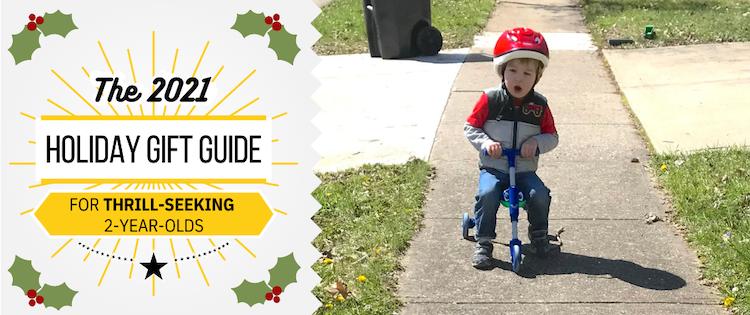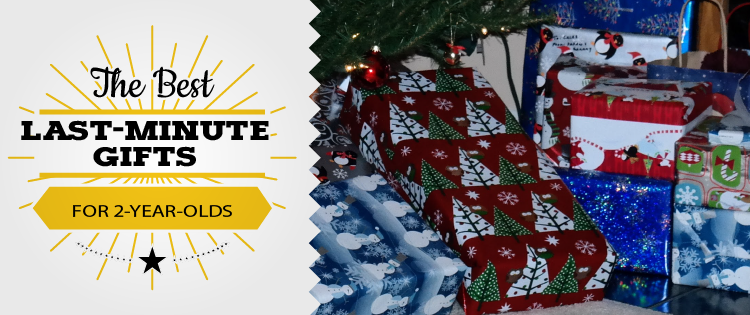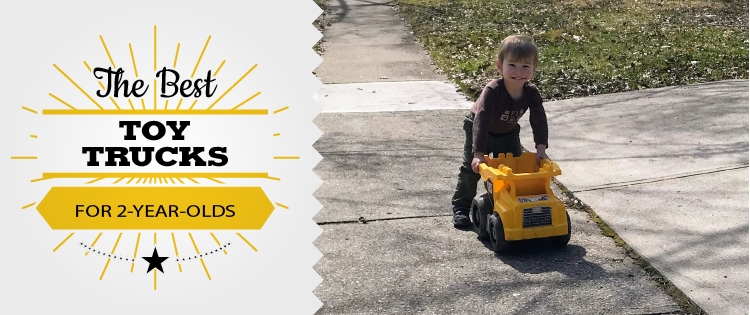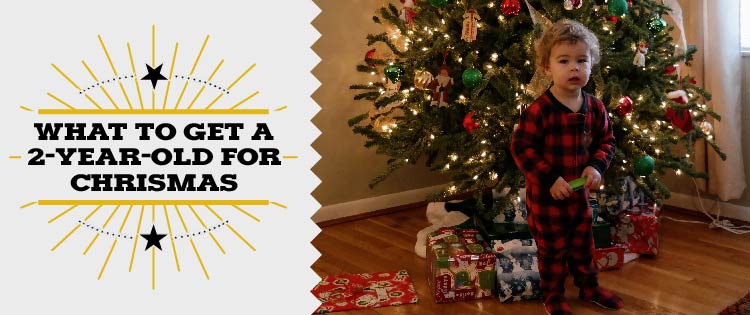Last Updated on November 9, 2021 by admin
This gift guide is for the sprinters, the climbers, and the “throw-yourself-off-a-high-place-ers.”
Of course, pigeonholing 2-year-olds into “types” is only helpful when it comes to things like choosing a toy category for a gift. The fact is that all tots are sometimes thrill-seeking, sometimes brainy, sometimes imaginative, and sometimes everything else.
That said, if you have a toddler who would love to fearlessly coast down a hill on wheels or feel the thrill of being pushed on a big swing, you’re in the right place to look for gift ideas.
Most of my gift guides are segmented into different price ranges. But as it turns out, all the “thrill-seeking” toys at the top of my recommendation list are all large, sturdy, and cost at least $50. If that’s in your budget, keep reading.
(As an Amazon Associate, I earn from qualifying purchases.)
A Nugget Couch

Unless you’ve been living under a rock for the past few years (or don’t have a small child living in your house), you’ve probably heard of the Nugget couch. It was in such a high demand for a while that all new stock sold out immediately.
“Wait,” you might object. “Isn’t a couch the opposite of thrill-seeking?” Well, it turns out that when a couch is well-designed for little kids, it can satisfy needs for both thrill-seeking and relaxing.
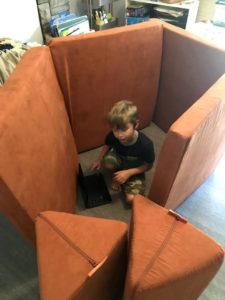
I’ve already written about how the one thing my kids have played the most with of all time is an old mattress. We use it as a basement playroom crash pad. If you want a crash pad but don’t have a mattress (or just want a classier option), crash pads tend to cost at least $100. Every gymnastics mat I see on Amazon is also at least $100.
The Nugget couch, although not exactly designed for crash pad use, certainly satisfies the need for a soft floor surface while ALSO serving as a nice looking piece of furniture, and a spare bed for kids’ sleepovers. With that in mind, it seems like a no-brainer at around $250, especially for something made in the USA.
Tubelox (or a Climber)
I’m all about products that have longevity and multiple uses. At first glance, Tubelox doesn’t appear to be a “thrill-seeking” toy. But given the choice to go back in time to when my kids were little, I think I would have splurged on a set of these instead of a climber for my little thrill-seeker. (I thought about buying a climber like this one many times, but I never did. I wasn’t sure it would get used enough for long enough to justify the expense and the space required.)
With Tubelox, though, you can build a little climbing apparatus for your toddler and then modify it over time to keep them interested. What’s even better, though, your kids will use id for other things as they get older.
I know this because my 5- and 8-year-old love playing with the our neighbors’ set. They use the Tubelox to build things like pretend pickaxes and tridents for their imaginary adventures.
I don’t own a set myself, so I don’t know for sure if Tubelox would have been a hit as a climber. My neighbor isn’t exactly thrilled about all the set’s small components. (She received it as a gift). But, I still think it’s a solid concept for an open-ended, versatile toy that was designed to be used for years.
A Saucer Swing (or “Platform Swing” or “Web Swing”)
You’ll have to make sure to watch your littlest kids while they’re playing on a swing like this. Toddlers can find a way to injure themselves, especially if you’ve attached the swing to a tree branch in such a way that it can rotate freely and possibly crash into the tree trunk.
The other threat for injury (and the one I’ve encountered much more frequently) is the potential to get clocked by the steel-core swing. This happens when they’re pushing themselves, o or running behind someone who has pushed the swing out of the way.
You can minimize the impact of those injuries by looking for a swing with a foam-padded base/ring. I’ve also had to set ground rules about keeping heads inside the swing and not letting them hang off the side. For what it’s worth, the biggest risks seem to be when you have an older kid who wants to push a younger one without fully appreciating how the swing moves.
All that said, if you have a suitable tree (or are willing to invest in a simple metal swingset frame) and can provide the supervision needed, these swings can provide lots of thrilling entertainment for years.
A Playset
There’s plenty of playsets online like this one that I can only imagine my kids would have loved when they were smaller. When you order a set like this off of Amazon you can expect to have to spend a decent amount of time assembling it yourself. But if your kid is a climber, it just might be well worth it.
A Ride-On Toy That Requires Balance
In case you haven’t heard, parents are opting away from tricycles for toddlers. Instead, they’re looking for ride-on toys that focus more on helping kids develop the skill of balance.
Here are the top balancing ride-on toys that could make great gifts for a thrill-seeking 2-year-old.
Balance Bikes
Balance bikes have two wheels, no pedals and no chain. They’re also called “pedal-free bikes” and “push bikes” because kids ride them by pushing off the ground with their feet. Unlike the stable, three-wheeled tricycles we had as toddlers, balance bikes help kids learn the balance and body control they’ll need to ride a “real” bike.
When I first got a balance bike for my son, I wrote a post explaining how to know whether your 2-year-old was ready for a balance bike and how to choose a model. Among other factors, I mentioned that one of the best ways to tell if they were ready for a balance bike was to see if they could zoom around con less advanced ride-on toys, such as a Scuttlebug. My kids got tons of use out of their Scuttlebug, which my oldest kid had just figured out how to ride when he turned two.
I waited until my 2-year-old turned 3 to get a balance bike with air tires (instead of the standard foam tires). But, if your 2-year-old was an early walker, is on the adventurous side, and already enthusiastically uses other balance toys (like rocking horses, “hopper” toys, and play roller coasters) they might be ready for a more advanced bike like the one shown here.
A “Baby” Balance Bike or Ride-On Toy
Another term that wasn’t around when my own kids were two is “baby balance bike.” There are plenty of ride-on toys on the market now that purposely position themselves as the step before a chid is ready for a “real” balance bike.
Another fun alternative to the Scuttlebug that my own kids loved is the Pewi from YBike.
This ride-on toy has the kind of free-rotating caster wheels you’d find on a desk chair.
If your 2-year-old just turned 2 or is a little more cautious, they could also use the Pewi as a walker/push-toy before they’re ready to roll around on it.
A 3-in-1 Balance Bike
Not sure whether to go with a balance bike or a baby balance bike? You might be interested in a 3-in-1 bike like the one shown here.
These bikes can start with the wheels farther apart for more stability. You can gradually adjust the wheels inwards to create a balance bike. Some also have a tricycle mode.
Cycling purists might object that the body position that’s ideal for pedaling might not be ideal for scooting. So, if you have more than one kid and have the space, I think it makes sense to start with a less advanced ride-on toy designed for younger two-year-olds. Then, you can upgrade to a “real” balance bike (maybe even one with air tires!) when they’re ready and let your younger kid use the less advanced ride-on toy.
A Convertible Scooter
Some kids simply feel more comfortable with their feet closer to the ground.
Scooters can be just as fun as bikes, and they still require kids to balance. This convertible scooter lets kids start scooting in a seated position and work up to a standing one.
Choosing a Balancing Ride-On Toy
As you’re shopping, try to keep in mind that many of the disgruntled reviews I see on these “baby balance bike” and “3-in-1 balance bike” product pages are from people who find the product to be the wrong size for their kid. Kids vary a lot in height and in athletic ability at any given age, so don’t take anything for granted before you buy.
Whichever type you choose, make sure you measure your kid’s inseam first so you understand what a reasonable ride-on toy will be for them. (I discuss more about how to measure you child for a bike in my balance bike post.)

